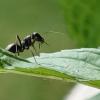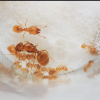- Formiculture.com
- Forums
- Gallery
- Members
- Member Map
- Chat

Any tips on finding Formica Queens?
Started By
DJoseph98
, Jun 23 2019 11:39 AM
6 replies to this topic
#1
 Offline
-
Posted June 23 2019 - 11:39 AM
Offline
-
Posted June 23 2019 - 11:39 AM
I know Formica are supposed to be starting their flights about now or soon enough, so I was wondering how you guys found the ones you have. Night time walks or did you just happen on them randomly? Do they fly shortly after rain or wait a day? I'm hoping to catch some polygynous species native to Kentucky.
Current Colonies
1 x Camponotus nearcticus (Monogynous), 1 x Crematogaster cerasi (Monogynous), 1 x Formica cf. subsericea (Polygynous Two-Queen), 1 x Formica cf. pallidefulva (Monogynous, single worker),
1 x Lasius cf. americanus (Pleometrotic Founding, now Monogynous), 1 x Tetramorium immigrans (Monogynous)
Current Founding Units
1 x Formica cf. subsericea (Monogynous)
Up-To-Date as of 9/15/2020
#2
 Offline
-
Posted June 23 2019 - 11:47 AM
Offline
-
Posted June 23 2019 - 11:47 AM
I found several last year (all during the day, and all afternoon to evening (about 1:00 - 9:00)). They all flew a day or two after rain, but never directly after it. I tended to find them all on concrete surfaces, such as my patio. I live in Indiana, so you may have different flight times, but Formica flew starting June 15 for me last year and continued till about July 10th. I haven’t seen any this year though, but I can almost garuntee that if you go outside in the evenings, you’ll DEFINITELY find some. Good luck! 
Edited by CatsnAnts, June 23 2019 - 11:47 AM.
- DJoseph98 likes this
Spoiler
#3
 Offline
-
Posted June 23 2019 - 11:51 AM
Offline
-
Posted June 23 2019 - 11:51 AM
Thanks! Where I'm at its been storming and raining for like a month (maybe a single dry day a week). We have a dry week coming up so I'll be out looking.
Current Colonies
1 x Camponotus nearcticus (Monogynous), 1 x Crematogaster cerasi (Monogynous), 1 x Formica cf. subsericea (Polygynous Two-Queen), 1 x Formica cf. pallidefulva (Monogynous, single worker),
1 x Lasius cf. americanus (Pleometrotic Founding, now Monogynous), 1 x Tetramorium immigrans (Monogynous)
Current Founding Units
1 x Formica cf. subsericea (Monogynous)
Up-To-Date as of 9/15/2020
#4
 Offline
-
Posted June 23 2019 - 1:24 PM
Offline
-
Posted June 23 2019 - 1:24 PM
Thanks! Where I'm at its been storming and raining for like a month (maybe a single dry day a week). We have a dry week coming up so I'll be out looking.
I live in southern Indiana, we’ve been having that same storm and haven’t had but 1 dry day either
Spoiler
#5
 Offline
-
Posted June 23 2019 - 2:13 PM
Offline
-
Posted June 23 2019 - 2:13 PM
I've found some Formica pallidefulva and F. fusca (I think?) queens the last couple years, and it always seemed to be primarily between 11AM and 1 PM with some stragglers afterwards. Like CantsnAnts said, it was usually a day or two after a rain, when things were still humid but there was no puddles remaining. I'm not sure how standard that is for other species, though.
Good luck. Formica queens hate light and vibrations more than any other genus I've had, so be prepared to give them some peace and quiet.
- DJoseph98 likes this
#6
 Offline
-
Posted June 25 2019 - 9:58 AM
Offline
-
Posted June 25 2019 - 9:58 AM
I've found some Formica pallidefulva and F. fusca (I think?) queens the last couple years, and it always seemed to be primarily between 11AM and 1 PM with some stragglers afterwards. Like CantsnAnts said, it was usually a day or two after a rain, when things were still humid but there was no puddles remaining. I'm not sure how standard that is for other species, though.
Good luck. Formica queens hate light and vibrations more than any other genus I've had, so be prepared to give them some peace and quiet.
Thanks for all the advise! I'll definitely be using it now that I finally found one and posted for an ID. Here's a sneak peek

Current Colonies
1 x Camponotus nearcticus (Monogynous), 1 x Crematogaster cerasi (Monogynous), 1 x Formica cf. subsericea (Polygynous Two-Queen), 1 x Formica cf. pallidefulva (Monogynous, single worker),
1 x Lasius cf. americanus (Pleometrotic Founding, now Monogynous), 1 x Tetramorium immigrans (Monogynous)
Current Founding Units
1 x Formica cf. subsericea (Monogynous)
Up-To-Date as of 9/15/2020
#7
 Offline
-
Posted June 29 2019 - 1:14 PM
Offline
-
Posted June 29 2019 - 1:14 PM
I know Formica are supposed to be starting their flights about now or soon enough, so I was wondering how you guys found the ones you have. Night time walks or did you just happen on them randomly? Do they fly shortly after rain or wait a day? I'm hoping to catch some polygynous species native to Kentucky.
I just find them wandering along the pavement. They're quite conspicuous. From my experience, they also are some of the fastest queens around.
"God made..... all the creatures that move along the ground according to their kinds (including ants). And God saw that it was good. Genesis 1:25 NIV version
Keeping:
Formica cf. pallidefulva, cf. incerta, cf. argentea
Formica cf. aserva, cf. subintegra
Myrmica sp.
Lasius neoniger, brevicornis
0 user(s) are reading this topic
0 members, 0 guests, 0 anonymous users

















